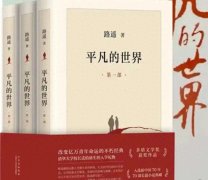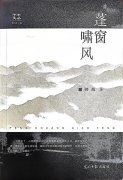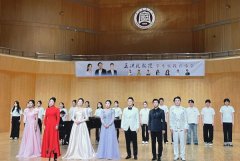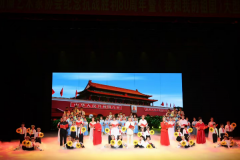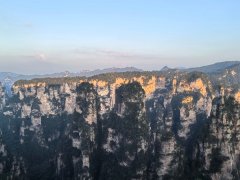拿到这本由浙江文艺出版社出版的《诗路浙江》样书时,我当即被其独具韵味、淡雅精致的装帧设计所吸引。翻开这本书,更为它优雅的体例布局、古朴淳厚的插图设计以及优美的文字所折服。《诗路浙江》以钱塘江诗路、大运河诗路、浙东诗路和瓯江诗路为主体线索,涉及浙江全境11个地级市,钱塘江、瓯江、大运河、富春江等知名水系;会稽山、天台山、雁荡山等知名山岳;西湖、灵隐寺、严陵钓台等知名景点。从中国历史上选取120首左右描写四条诗路的古典诗词,如《梦游天姥吟留别》《钱塘湖春行》等,并加以赏析。同时,全书配上描绘四条诗路的知名古画,如《富春山居图》《西湖十景》等。全方位展现诗词与浙江山水的联系,展现浙江的文化之美、生态之美、气韵之美、活力之美。
●《诗路浙江》,2021年浙江文艺出版社出版,作者林岩。品诗词之美,看浙江山水。 中华文化源远流长、灿烂辉煌。在5000多年文明发展中孕育的中华优秀传统文化,积淀着中华民族最深沉的精神追求,代表着中华民族独特的精神标识,是中华民族生生不息、发展壮大的丰厚滋养,是根植中国特色社会主义的文化沃土,是当代中国发展的突出优势,对延续和发展中华文明、促进人类文明进步,发挥着重要作用。近年来,中央在保护传承中华优秀传统文化方面做出了许多重要部署,包括出台了《关于实施中华优秀传统文化传承发展工程的意见》等。为此,浙江省提出建设大运河、钱塘江、浙东、瓯江四条诗路文化带,并对这项工作做出了全面的规划与部署。之后,浙江全省在诗路文化的建设与发展上做了大量的工作,这次浙江文艺出版社出版《诗路浙江》,是其中浓墨重彩的一笔。 诗是文学中的文学,广义的诗是一切艺术的统称,是自然美、艺术美和人生美的代名词,是人类观照世界的重要方式。古人说,诗言志。我也常想,从古到今,诗人们为什么要写诗。据我考察,大体上有如下原因:一是抒发情怀,二是感悟人生,三是寄情山水,四是讴歌友情,五是触景生情,六是感叹万物……正因为人有丰富的情感,于是就有了抒情达意最好的方式之一——诗词。中华民族数千年的文明史,先人们留下了无数灿若星辰的诗词歌赋。
●石梁飞瀑处于浙东唐诗之路带上 浙江乃古越之地,自古丽逸江南、山灵水秀、人文蔚兴,先人山高水长之风、两浙钟灵毓秀之境,吸引了历代思想先哲、文人墨客来浙江游历歌咏。杭州美景,让晚年居家养老的白居易念念不忘,写下“江南忆,最忆是杭州。山寺月中寻桂子,郡亭枕上看潮头。何日更重游”的名篇;钱塘江大潮,让苏轼写下“万人鼓噪慑吴侬,犹是浮江老阿童。欲识潮头高几许?越山浑在浪花中”的佳作;天台妙境,让李白写下“天台邻四明,华顶高百越。门标赤城霞,楼栖沧岛月。凭高登远览,直下见溟渤。云垂大鹏翻,波动巨鳌没”的名句;永嘉山水,让谢灵运写下“池塘生春草,园柳变鸣禽”的旷世之作,开创了山水诗创作的新天地。书写浙江的诗词,成千上万,难以计数。东晋南朝是浙江诗路文化的发生期,唐宋是诗路文化的兴盛繁荣期,明清是诗路文化的深化融合期。先人择水而居,繁衍生息,以水系(古道)为纽带贯穿浙江全省,勾勒出了浙江诗路文化的诗人行迹图、水系交通图、遗产风物图、名城古镇图、浙学学脉图“五幅地图”,分别绘就钱塘江诗路、大运河诗路、浙东诗路、瓯江诗路“四条诗路”,文化之魂深深镌刻在浙江大地上,是历史留给浙江的宝贵财富,是浙江人民生生不息的精神动力与文化情怀。
●谢灵运像 浙江省委省政府提出打造“四条诗路”的决策部署,建设诗路文化带,是全省“大花园”建设的标志性工程,是打造文化浙江的时代亮点,对展示现代版《富春山居图》,打响“诗画浙江”金名片,深入践行“绿水青山就是金山银山”理念,全面推进“两个高水平”建设,都具有重要意义。“四条诗路”串起千村百镇、串起江南文化,为浙江打造文化高地、文明高地提供新的路径,形成浙江文化精华之“链”、山水之“链”、全域发展之“链”,走出一条世代传承的文化自信之路、绿色生态文明之路、勇立潮头的高质量发展之路。全书精选历代诗人吟咏浙江的佳作一百多首,分置于“四条诗路”之下,每条诗路又对应各自地区,条目十分清晰。每首诗词,皆有独到的赏析评点,使读者在对诗词的品鉴中,对浙江诗路之存在获得深入的理解。诗路既是诗歌之路,也是山水之路,因此,书中还配有历代描摹山水的古画近百幅,真是诗中有画,画中有诗,诗路浙江,做到了诗画合一。
●新安江处于钱塘江唐诗之路带上 美丽浙江,诗路沿线城镇繁华、经济繁荣、文化兴盛,展现了浙江创新发展的活力。随着经济社会的发展,浙江正在打造共同富裕示范区,老百姓的日子越过越好。美好生活不仅体现于衣食住行的富足,更在于精神文化的丰裕。当此盛世,正是弘扬优秀传统文化、做出优异成绩的良好时机。《诗路浙江》就是这一时代背景的产物。这本漂亮、精致、好读、耐看的书,将向广大读者普及浙江“四条诗路”背后的文化故事,讲述浙江历史的悠久,展现浙学的文化魅力。期待这本书既为浙江诗路的研究提供有益借鉴,也为读者提供一份别样精彩的精神食粮。如此,功莫大焉。
The Beauty of Zhejiang’s Poetry Roads When I got Poetry Roads in Zhejiang, published by the Zhejiang Literature and Art Publishing House, I was immediately attracted by its charming and exquisite design. Opening this book, I was again fascinated by its elegant layout, its simple and vintage illustrations and above all its beautifully written poetry and analysis. As the title suggests, one of the main threads of the book is the four poetry roads of Zhejiang, i.e. the Qiantang River Poetry Road, the Grand Canal Poetry Road, the Oujiang River Landscape Poetry Road and the Tang Poetry Road in East Zhejiang, which covers all the 11 prefecture-level cities of the province, renowned mountains such as the Kuaiji Mountain, the Tiantai Mountain, the Yandang Mountain, as well as popular scenic spots such as the West Lake and the Lingyin Temple. The other main thread is the 120 celebrated Chinese poems that have been specially selected for appreciation and analysis. Coupled with illustrations, most of which are famous paintings about places along the four poetry roads, the book has presented the readers with a beautiful Zhejiang in culture and ecology, a charming Zhejiang in temperament and vitality.
●用诗词与山水画串联起浙江的山水人文、气韵活力,诗中有景、景中有诗。 Over the past 5,000 years, a fine traditional culture has been born out of the Chinese civilization, the accumulation of the deepest spiritual pursuit of the Chinese nation and the epitome its unique spiritual identity. In recent years, the Chinese government has issued a series of policies in protecting and inheriting China’s fine traditional culture. Accordingly, Zhejiang province has proposed the aforementioned four poetry roads or cultural belts and made a comprehensive plan. Since then, extensive work has been carried out in its implementation, of which Poetry Roads in Zhejiang is an important part. Poetry is literature within literature. In a broader sense, poetry is a general term for all forms of arts and an important way for human beings to see the world. Indeed, as the ancients used to say, poetry is an expression of one’s aspirations. I have often wondered why poets have written poetry throughout history. I believe they do so for the following reasons: to express emotions; to show an understanding of life; to communicate feelings through mountains and rivers; to eulogize friendship; because emotions and feelings are stirred up by what they see; or to lament for everything. There is no doubt that one of the best ways to convey emotions and feelings is through poetry and in Chinese history, the classical poets have penned countless poems.
●云和处于瓯江山水诗之路带上 As the place where the state of Yue (2032-222 BC) was born, Zhejiang has been known for its charming landscape, hospitable people and unique culture, drawing sages, literati and poets alike over the generations. Bai Juyi (772-846) for instance, still pined for Hangzhou’s mesmerizing scenery in his later years, “When I remember Jiangnan [south of the Yangtze River], most fondly I remember Hangzhou.” Su Shi, marveling at the magnificent Qiantang River tidal bore, exclaimed, “How high can the crest of the waves soar? Even the Yue mountains are buried beneath all.” Li Bai (701-762), traveling on the Tiantai Mountain, declared, “Looking far into the distance up high, the seas are directly under my eye.” Xie Lingyun (385-433), the pioneer of the landscape poetry genre, wrote, ”Spring grass grows rampantly over the pond and myriad birds chirp happily in the willows,” during his stay in Yongjia. From the Jin dynasty (266-420), when the “poetry road culture” began to germinate, through the Tang (618-907) and Song (960-1279) dynasties in its height, to the Ming (1368-1644) and Qing (1616-1911) dynasties when it firmly took root, tens of thousands of poems were written on Zhejiang. Although called poetry “roads”, they in fact run largely along the province’s major rivers, around which the forebearers of Zhejiang chose to live. The poetry road culture is a precious treasure bequeathed to Zhejiang, and the provincial government’s decision to build a Poetry Road Culture Belt has provided a new approach for the province’s cultural development, a major component of its pursuit for high-quality development.
●京杭大运河处于大运河文化带上 Indeed, the urban affluence, economic prosperity and cultural richness along the four poetry roads testify to Zhejiang’s dynamic of innovative development. At present, the province is working to establish a demonstration zone for common prosperity, as people here are living an ever better life. A good life is not only abundance in food, clothing, housing, transportation, among other material aspects; it also means spiritually and culturally prosperous. Poetry Roads in Zhejiang is born in such a context. This exquisite and readable book will help readers learn more about the stories behind the four poetry roads, about the history of Zhejiang and about Zhexue (the Zhejiang Scholarship). I hope this book will be useful for the research of the poetry roads, and supply readers with enough food for thought. (编辑:红云) |











